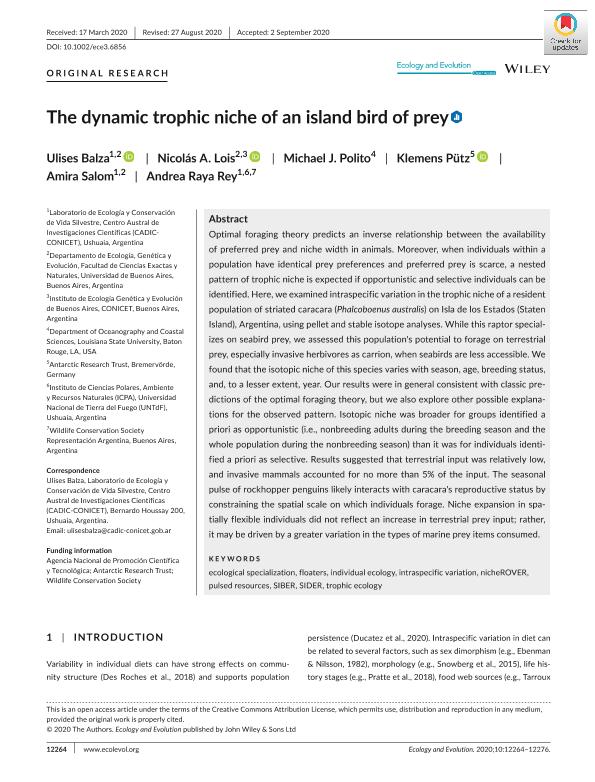Artículo
The dynamic trophic niche of an island bird of prey
Balza, Ulises ; Lois, Nicolás Alejandro
; Lois, Nicolás Alejandro ; Polito, Michael J.; Pütz, Klemens; Salom, Amira
; Polito, Michael J.; Pütz, Klemens; Salom, Amira ; Raya Rey, Andrea Nélida
; Raya Rey, Andrea Nélida
 ; Lois, Nicolás Alejandro
; Lois, Nicolás Alejandro ; Polito, Michael J.; Pütz, Klemens; Salom, Amira
; Polito, Michael J.; Pütz, Klemens; Salom, Amira ; Raya Rey, Andrea Nélida
; Raya Rey, Andrea Nélida
Fecha de publicación:
10/2020
Editorial:
John Wiley & Sons Ltd
Revista:
Ecology and Evolution
ISSN:
2045-7758
Idioma:
Inglés
Tipo de recurso:
Artículo publicado
Clasificación temática:
Resumen
Optimal foraging theory predicts an inverse relationship between the availability of preferred prey and niche width in animals. Moreover, when individuals within a population have identical prey preferences and preferred prey is scarce, a nested pattern of trophic niche is expected if opportunistic and selective individuals can be identified. Here, we examined intraspecific variation in the trophic niche of a resident population of striated caracara (Phalcoboenus australis) on Isla de los Estados (Staten Island), Argentina, using pellet and stable isotope analyses. While this raptor specializes on seabird prey, we assessed this population's potential to forage on terrestrial prey, especially invasive herbivores as carrion, when seabirds are less accessible. We found that the isotopic niche of this species varies with season, age, breeding status, and, to a lesser extent, year. Our results were in general consistent with classic predictions of the optimal foraging theory, but we also explore other possible explanations for the observed pattern. Isotopic niche was broader for groups identified a priori as opportunistic (i.e., nonbreeding adults during the breeding season and the whole population during the nonbreeding season) than it was for individuals identified a priori as selective. Results suggested that terrestrial input was relatively low, and invasive mammals accounted for no more than 5% of the input. The seasonal pulse of rockhopper penguins likely interacts with caracara's reproductive status by constraining the spatial scale on which individuals forage. Niche expansion in spatially flexible individuals did not reflect an increase in terrestrial prey input; rather, it may be driven by a greater variation in the types of marine prey items consumed.
Archivos asociados
Licencia
Identificadores
Colecciones
Articulos(CADIC)
Articulos de CENTRO AUSTRAL DE INVESTIGACIONES CIENTIFICAS
Articulos de CENTRO AUSTRAL DE INVESTIGACIONES CIENTIFICAS
Articulos(IEGEBA)
Articulos de INSTITUTO DE ECOLOGIA, GENETICA Y EVOLUCION DE BS. AS
Articulos de INSTITUTO DE ECOLOGIA, GENETICA Y EVOLUCION DE BS. AS
Citación
Balza, Ulises; Lois, Nicolás Alejandro; Polito, Michael J.; Pütz, Klemens; Salom, Amira; et al.; The dynamic trophic niche of an island bird of prey; John Wiley & Sons Ltd; Ecology and Evolution; 10; 21; 10-2020; 12264-12276
Compartir
Altmétricas



